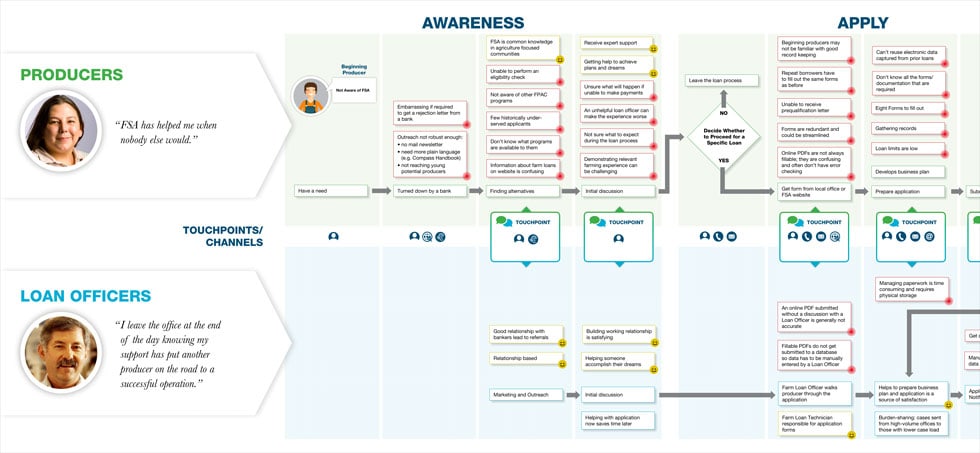What Is a Customer Journey Map?
[This is the first in a series of three articles on customer journey maps: what they are, how to read them, and how to use them to improve your customers’ experiences.]
In the first few months of our work with the U.S. Department of Agriculture (USDA), we started working with the Farm Service Agency (FSA) to better understand and improve the direct farm loan experience. A key document from that research was a customer journey map showing a typical farm loan experience from the viewpoints of both a loan applicant (a producer like a new farmer or rancher) and an FSA loan officer.
With the help of the journey map and accompanying research, the Customer Experience Center of Excellence (CX CoE) team was able to identify potential improvements that both producers and loan officers gave high priority—things like simplifying and pre-populating forms and adding online features (without detracting from highly valued face-to-face interactions). But how did the journey map contribute to those findings? How can you read a journey map to help reveal potential improvements?
Direct Farm Loans Customer Journey Map
As you can see, a journey map can be complex. If you’re unfamiliar with the format, it can be overwhelming at first glance. Here are some tips on how to read and use a customer journey map like a skilled Customer Experience (CX) practitioner.
What Is a Journey Map?
First, a journey map is a visual tool to help you better understand your customer’s experience. This allows you to make better decisions and build more effective solutions to fulfill their needs.
Journey maps give you an overview of your customers, from start to finish as they use your product or service. They include information about:
- The different steps a customer must go through (including official processes, workarounds, and additional incidental steps)
- Specific actions and decisions they must make
- Touchpoints, or ways customers interact with your people and systems (like through in-person meetings, emails, website content, or phone calls)
- Importantly, the emotions (both positive and negative) that they feel throughout the journey
The goal of a journey map is to give team members a common, research-based view of what the customer is trying to do, what they’re going through, and how they’re feeling. This view of the customer grounds the team in the human challenges they need to solve.
How Do You Make a Journey Map?
Before you can make a journey map, you have to do your homework, including doing desk research on business needs, systems, and customers; creating draft personas (generalized profiles of key customers) to represent who you’re designing solutions for; and immersing yourself with your customers and stakeholders in field interviews and observations. (Depending on the scope of your project, the research phase can last days, weeks, or sometimes a few months, but you should avoid never-ending research.) You’ll then work to organize and analyze your research to uncover patterns, trends, and insights. (See the Journey Map Process we used in Phase 1.)
Then, the team will work to translate those insights into a visual map, refining, and iterating to develop something that’s both a process diagram and a record of your stakeholders’ and customers’ emotional states.
There’s no single format for a journey map; they’ll be different based on the complexity of the process you’re looking at, as well as many other factors. A few considerations when making journey maps:
- They should be as simple as possible, while still conveying all the required information
- Journey maps can’t cover every customer type; instead, your journey map will represent a generalized experience of one type of key customer, based on your research (If you need to, you can make multiple journey maps.)
- They’re arranged chronologically (usually from left to right) with the individual steps grouped into phases (though sometimes the boundaries between phases can blur together)
- Journey maps present multiple dimensions of data (like touchpoints, actions, and emotions), displayed using an information hierarchy
After you create your journey map, you should validate it by showing it to people familiar with the process, including members of your key customer group.
In our next article, we’ll show you how you read a journey map, and how you can use that information to guide your efforts.
Return to Updates

